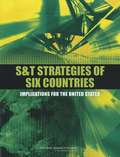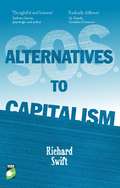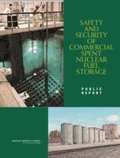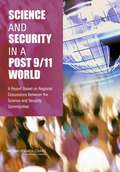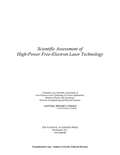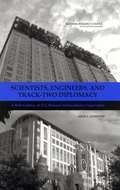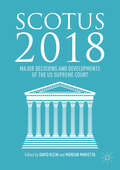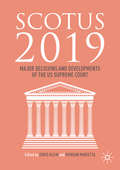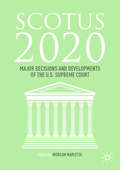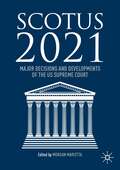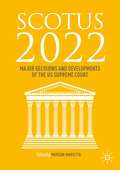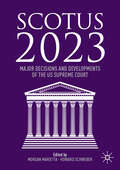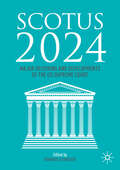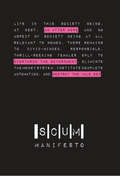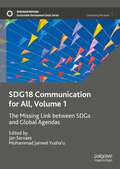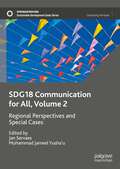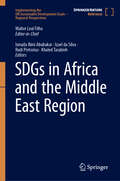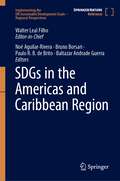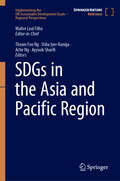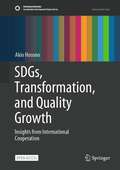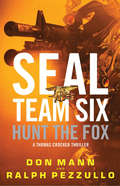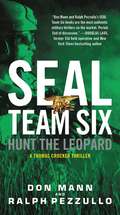- Table View
- List View
S&T Strategies of Six Countries: Implications for the United States
by National Research Council of the National AcademiesAn increase in global access to goods and knowledge is transforming world-class science and technology (S&T) by bringing it within the capability of an unprecedented number of global parties who must compete for resources, markets, and talent. In particular, globalization has facilitated the success of formal S&T plans in many developing countries, where traditional limitations can now be overcome through the accumulation and global trade of a wide variety of goods, skills, and knowledge. As a result, centers for technological research and development (R&D) are now globally dispersed, setting the stage for greater uncertainty in the political, economic, and security arenas. These changes will have a potentially enormous impact for U.S. national security policy, which for the past half century has been premised on U.S. economic and technological dominance. As the U.S. monopoly on talent and innovation wanes, arms export regulations and restrictions on visas for foreign S&T workers are becoming less useful as security strategies. The acute level of S&T competition among leading countries in the world today suggests that countries that fail to exploit new technologies or that lose the capability for proprietary use of their own new technologies will find their existing industries uncompetitive or obsolete. The increased access to information has transformed the 1950s' paradigm of "control and isolation" of information for innovation control into the current one of "engagement and partnerships" between innovators for innovation creation. Current and future strategies for S&T development need to be considered in light of these new realities. This book analyzes the S&T strategies of Japan, Brazil, Russia, India, China, and Singapore (JBRICS), six countries that have either undergone or are undergoing remarkable growth in their S&T capabilities for the purpose of identifying unique national features and how they are utilized in the evolving global S&T environment.
S.O.S. Alternatives to Capitalism
by Richard SwiftWith capitalism vulnerable and out-of-step in the wake of financial crises this book investigates the alternatives that are on offer-including socialism, anarchism, and deep ecology.<P><P> It picks its way through the pockets of resistant thinking and emerges with paths to changing the world that rest less on rigid ideology imposed from above than on practical transformation from below.Richard Swift is former editor of New Internationalist magazine and author of the No-Nonsense Guide to Democracy. In 2011, he won the Daniel Singer Millenium Prize for an original essay which helps further socialist ideas.
SAFETY AND SECURITY OF COMMERCIAL SPENT NUCLEAR FUEL STORAGE: Public Report
by National Research Council of the National AcademiesIn response to a request from Congress, the Nuclear Regulatory Commission and the Department of Homeland Security sponsored a National Academies study to assess the safety and security risks of spent nuclear fuel stored in cooling pools and dry casks at commercial nuclear power plants. The information provided in this book examines the risks of terrorist attacks using these materials for a radiological dispersal device. Safety and Security of Commercial Spent Nuclear Fuel is an unclassified public summary of a more detailed classified book. The book finds that successful terrorist attacks on spent fuel pools, though difficult, are possible. A propagating fire in a pool could release large amounts of radioactive material, but rearranging spent fuel in the pool during storage and providing emergency water spray systems would reduce the likelihood of a propagating fire even under severe damage conditions. The book suggests that additional studies are needed to better understand these risks. Although dry casks have advantages over cooling pools, pools are necessary at all operating nuclear power plants to store at least the recently discharged fuel. The book explains it would be difficult for terrorists to steal enough spent fuel to construct a significant radiological dispersal device.
SBIR at the Department of Defense
by Technology Committee on Capitalizing on Science Innovation An Assessment Of The Small Busin Program—Phase IICreated in 1982 through the Small Business Innovation Development Act, the Small Business Innovation Research (SBIR) program remains the nation's single largest innovation program for small business. The SBIR program offers competitive awards to support the development and commercialization of innovative technologies by small private-sector businesses. At the same time, the program provides government agencies with technical and scientific solutions that address their different missions. "SBIR at the Department of Defense" considers ways that the Department of Defense SBIR program could work better in addressing the congressional objectives for the SBIR program to stimulate technological innovation, use small businesses to meet federal research and development (R & D) needs, foster and encourage the participation of socially and economically disadvantaged small businesses, and increase the private sector commercialization of innovations derived from federal R&D. An earlier report, "An Assessment of the Small Business Innovation Research Program at the Department of Defense," studied how the SBIR program has stimulated technological innovation and used small businesses to meet federal research and development needs. This report builds on the previous one, with a revised survey of SBIR companies. "SBIR at the Department of Defense" revisits some case studies from the 2009 study and develops new ones, and interviews agency managers and other stakeholders to provide a second snapshot of the program's progress toward achieving its legislative goals.
SBIR at the National Science Foundation
by Technology Committee on Capitalizing on Science Innovation An Assessment Of The Small Busin Program-Phase IIThe Small Business Innovation Research (SBIR) program is one of the largest examples of U. S. public-private partnerships, and was established in 1982 to encourage small businesses to develop new processes and products and to provide quality research in support of the U. S. government’s many missions. The U. S. Congress tasked the National Research Council with undertaking a comprehensive study of how the SBIR program has stimulated technological innovation and used small businesses to meet federal research and development needs, and with recommending further improvements to the program. In the first round of this study, an ad hoc committee prepared a series of reports from 2004 to 2009 on the SBIR program at the five agencies responsible for 96 percent of the program’s operations -- including the National Science Foundation (NSF). Building on the outcomes from the first round, this second round presents the committee’s second review of the NSF SBIR program’s operations. Public-private partnerships like SBIR are particularly important since today's knowledge economy is driven in large part by the nation's capacity to innovate. One of the defining features of the U. S. economy is a high level of entrepreneurial activity. Entrepreneurs in the United States see opportunities and are willing and able to assume risk to bring new welfare-enhancing, wealth-generating technologies to the market. Yet, although discoveries in areas such as genomics, bioinformatics, and nanotechnology present new opportunities, converting these discoveries into innovations for the market involves substantial challenges. The American capacity for innovation can be strengthened by addressing the challenges faced by entrepreneurs.
SCIENCE AND SECURITY IN A POST 9/11 WORLD: A Report Based on Regional Discussions Between the Science and Security Communities
by National Research Council of the National AcademiesBased on a series of regional meetings on university campuses with officials from the national security community and academic research institutions, this report identifies specific actions that should be taken to maintain a thriving scientific research environment in an era of heightened security concerns. Actions include maintaining the open exchange of scientific information, fostering a productive environment for international scholars in the U.S., reexamining federal definitions of sensitive but unclassified research, and reviewing policies on deemed export controls. The federal government should establish a standing entity, preferably a Science and Security Commission, that would review policies regarding the exchange of information and the participation of foreign-born scientists and students in research.
SCIENTIFIC ASSESSMENT OF High-power Free-electron Laser Technology
by National Research Council of the National AcademiesThis book presents a scientific assessment of free-electron-laser technology for naval applications. The charge from the Office of Naval Research was to assess whether the desired performance capabilities are achievable or whether fundamental limitations will prevent them from being realized. The present study identifies the highest-priority scientific and technical issues that must be resolved along the development path to achieve a megawatt-class free-electron laser. In accordance with the charge, the committee considered (and briefly describes) trade-offs between free-electron lasers and other types of lasers and weapon systems to show the advantages free-electron lasers offer over other types of systems for naval applications as well as their drawbacks. The primary advantages of free-electron lasers are associated with their energy delivery at the speed of light, selectable wavelength, and all-electric nature, while the trade-offs for free-electron lasers are their size, complexity, and relative robustness. Also, Despite the significant technical progress made in the development of high-average-power free-electron lasers, difficult technical challenges remain to be addressed in order to advance from present capability to megawatt-class power levels.
SCIENTISTS, ENGINEERS, AND TRACK-TWO DIPLOMACY: A Half-Century of U.S.-Russian Interacademy Cooperation
by Glenn E. SchweitzerThis report is intended to provide a brief historical perspective of the evolution of the interacademy program during the past half-century, recognizing that many legacies of the Soviet era continue to influence government approaches in Moscow and Washington and to shape the attitudes of researchers toward bilateral cooperation in both countries (of special interest is the changing character of the program during the age of perestroika (restructuring) in the late 1980s in the Soviet Union); to describe in some detail the significant interacademy activities from late 1991, when the Soviet Union fragmented, to mid-2003; and to set forth lessons learned about the benefits and limitations of interacademy cooperation and to highlight approaches that have been successful in overcoming difficulties of implementation.
SCOTUS 2018: Major Decisions and Developments of the US Supreme Court
by David Klein Morgan MariettaEach year, the Supreme Court of the United States announces new rulings with deep consequences for our lives. This inaugural volume in Palgrave’s new SCOTUS series describes, explains, and contextualizes the landmark cases of the US Supreme Court in the term ending in 2018, covering issues such as gay rights, religious liberty, public sector unions, coerced speech, digital privacy, voting rights, and the Trump travel ban. Bringing together notable scholars of the Court in one volume, the chapters in Scotus 2018 present the details of each ruling in its specific case, its meaning for constitutional debate, and its impact on public policy or partisan politics. Finally, SCOTUS 2018 offers a big-picture look at Justice Neil Gorsuch’s first full term in office, the legal and political legacy of former Justice Anthony Kennedy, and the controversial nomination and confirmation of Justice Brett Kavanaugh.
SCOTUS 2019: Major Decisions and Developments of the US Supreme Court
by David Klein Morgan MariettaEach year, the Supreme Court of the United States announces new rulings with deep consequences for our lives. This second volume in Palgrave’s SCOTUS series explains and contextualizes the landmark cases of the US Supreme Court in the term ending 2019. With a close look at cases involving key issues and debates in American politics and society, SCOTUS 2019 tackles the Court's rulings on the census citizenship question, partisan gerrymandering, religious monuments, the death penalty, race in jury selection, double jeopardy, jury trials for reimprisonment during supervised release, Fourth Amendment protection for blood alcohol tests, deference to federal agencies, excessive fines under the Eighth Amendment and more. Written by notable scholars in political science and law, the chapters in SCOTUS 2019 present the details of each ruling, its meaning for constitutional debate, and its impact on public policy or partisan politics. Finally, SCOTUS 2019 offers an analysis of the controversial Justice Brett Kavanaugh's first term in office, as well as a big-picture look at the implications of the Court's decisions for the direction of this new Roberts Court.
SCOTUS 2020: Major Decisions and Developments of the U.S. Supreme Court
by Morgan MariettaEach year, the Supreme Court of the United States announces new rulings with deep consequences for our lives. This third volume in Palgrave’s SCOTUS series describes, explains, and contextualizes the landmark cases of the US Supreme Court in the term ending 2020. With a close look at cases involving key issues and debates in American politics and society, SCOTUS 2020 tackles the Court’s rulings on LGBT discrimination, abortion regulation, subpoenas of the Trump administration, the Electoral College, DACA and presidential power, Native rights, cross-border rights, the Second Amendment, church and state, separation of powers, criminal justice, and more. Written by notable scholars in political science and law, the chapters in SCOTUS 2020 present the details of each ruling, its meaning for constitutional debate, and its impact on public policy or partisan politics. Finally, SCOTUS 2020 offers an analysis of the current state of ideological and interpretive divisions on the Court.
SCOTUS 2021: Major Decisions and Developments of the US Supreme Court
by Morgan MariettaEach year, the Supreme Court of the United States announces new rulings with deep consequences for our lives. This fourth volume in Palgrave’s SCOTUS series describes, explains, and contextualizes the landmark cases of the US Supreme Court in the term ending 2021. With a close look at cases involving key issues and debates in American politics and society, SCOTUS 2021 tackles the Court’s rulings on voting rights, Obamacare, LGBT rights, climate change, college sports, property rights, separation of powers, parole for youth offenders, immigration, religious liberty, free speech, and more. Written by notable scholars in political science and law, the chapters in SCOTUS 2021 present the details of each ruling, its meaning for constitutional debate, and its impact on public policy or partisan politics. Finally, SCOTUS 2021 offers an analysis of the legacy of Justice Ruth Bader Ginsburg.
SCOTUS 2022: Major Decisions and Developments of the US Supreme Court
by Morgan MariettaEach year, the Supreme Court of the United States announces new rulings with deep consequences for our lives. This fifth volume in Palgrave’s SCOTUS series describes, explains, and contextualizes the landmark cases of the US Supreme Court in the term ending 2022. With a close look at cases involving key issues and debates in American politics and society, SCOTUS 2022 tackles the Court’s rulings on abortion, guns, religion, environmental regulation, pandemic controls, immigration and more. Written by notable scholars in political science and law, the chapters in SCOTUS 2022 present the details of each ruling, its meaning for constitutional debate, and its impact on public policy or partisan politics. Finally, SCOTUS 2022 offers an analysis of the current ideological and interpretive divisions on the Court, including an analysis of the unprecedented leak of the Dobbs draft ruling.
SCOTUS 2023: Major Decisions and Developments of the US Supreme Court
by Morgan Marietta Howard SchweberEach year, the Supreme Court of the United States announces new rulings with deep consequences for our lives. This sixth volume in Palgrave’s SCOTUS series describes, explains, and contextualizes the landmark cases of the US Supreme Court in the term ending 2023. With a close look at cases involving key issues and debates in American politics and society, SCOTUS 2023 tackles the Court’s rulings on affirmative action, LGBT equality, internet platform liability, the Clean Water Act, immigration enforcement, and more. Written by notable scholars in political science and law, the chapters in SCOTUS 2023 present the details of each ruling, its meaning for constitutional debate, and its impact on public policy or partisan politics. Finally, SCOTUS 2023 offers an analysis of Justice Ketanji Brown Jackson's first year on the court, as well as court reform.
SCOTUS 2024: Major Decisions and Developments of the US Supreme Court
by Howard SchweberEach year, the Supreme Court of the United States announces new rulings with deep consequences for our lives. This seventh volume in Palgrave’s SCOTUS Decisions series explains and contextualizes the landmark cases of the US Supreme Court in the term ending 2024. With a close look at cases involving key issues and debates in American politics and society, SCOTUS 2024 tackles the Court's rulings on ballot access, executive immunity, access to mifepristone, funding of the Consumer Financial Protection Bureau, the Equal Protection clause and state redistricting, the Securities and Exchange Commission's ability to levy civil penalties, the power of federal agencies to interpret the laws they administer, the the Environmental Protection Agency's ability to reduce air pollution from power plants, and more. Written by notable scholars in political science and law, the chapters in SCOTUS 2024 present the details of each ruling, its meaning for constitutional debate, and its impact on public policy or partisan politics. Finally, SCOTUS 2024 analyzes ethics scandals on the Court and charts its shifts in ideology.
SCUM Manifesto
by Valerie SolanasFirst circulated on the streets of Greenwich Village in 1967, the SCUM Manifesto is a searing indictment of patriarchal culture in all its forms.<P><P> Shifting fluidly between the worlds of satire and straightforward critique, this no-holds-barred classic is a call to action-a radical feminist vision for a different world. This is an update of the essential AK Press edition, with a new foreword.Valerie Solanas was a radical feminist playwright and social propagandist who was arrested in 1968 after her attempted assassination of Andy Warhol. Deemed a paranoid schizophrenic by the state, Solanas was immortalized in the 1996 film I Shot Andy Warhol.
SDG18 Communication for All, Volume 1: The Missing Link between SDGs and Global Agendas (Sustainable Development Goals Series)
by Jan Servaes Muhammad Jameel Yusha’uThe 2030 agenda for development, or what is known as the Sustainable Development Goals (SDGs), is the most ambitious agenda collectively agreed upon by 193 countries in human history. In 2015, the UN Member States adopted the 17 SDGs as a framework that would help address the challenges being faced by humanity. From eradicating poverty, ending hunger, providing universal access to healthcare and education, and addressing climate change; to the partnering of individuals, communities, and nation-states to achieve global goals. Yet, the framers of the 2030 agenda forgot to dedicate one goal focused on the role of communication in achieving the SDGs. It is nearly impossible to achieve the SDGs without the articulation and embrace of the role of communication in development. Today, development has become a communication issue, and communication is a development issue. How could such a vital pillar of life be missing in the UN's Sustainable Development Goals? Volume 1 provides an overview of what the contributors have termed as the 'missing link' between existing SDGs: Communication for All.
SDG18 Communicaton for All, Volume 2: Regional Perspectives and Special Cases (Sustainable Development Goals Series)
by Jan Servaes Muhammad Jameel Yusha’uThe 2030 agenda for development, or what is known as the Sustainable Development Goals (SDGs), is perhaps the most ambitious agenda collectively agreed upon by 193 countries in human history. Yet, the framers of the 2030 agenda for development forgot to dedicate one goal focused on the role of communication in achieving the SDGs. Such oversight has attracted the attention of media and communication scholars alike, journalists, and policymakers who understand that it is nearly impossible to achieve the SDGs without the articulation and embrace of the role of communication in development. Volume 2 provides in-depth and specific explorations into regional perspectives concerning communication and the SDGs, with research on a rich array of sources, including Latin America, Africa, Australia, as well as special cases relating to timely studies such as social media, COVID-19, marginalized voices, and women's equality.
SDGs in Africa and the Middle East Region (Implementing the UN Sustainable Development Goals – Regional Perspectives)
by Walter Leal FilhoAfrica is one of the most vulnerable regions, and one where the implementation of the SDGs is particularly urgent. Underinvestments in natural conservation are increasing the vulnerability of people across many African countries, whose well-being is endangered by deteriorating socio-economic and environmental conditions. This volume provides a contribution towards showcasing how natural resources may be more efficiently used and investments may be mobilised to augment the limited public sector funds available to achieve the SDGs.This book is part of the "100 papers to accelerate the implementation of the UN Sustainable Development Goals initiative".
SDGs in the Americas and Caribbean Region (Implementing the UN Sustainable Development Goals – Regional Perspectives)
by Bruno Borsari Noé Aguilar-Rivera Paulo R. B. de Brito Baltazar Andrade GuerraThis volume provides an overview of the ways sustainable development issues as a whole, and the SDGs in particular, are perceived and practiced in a variety of countries in the Latin America and Caribbean region. It also discusses the extent to which its many socio-economic problems hinder progresses towards the pursuit of a sustainable future, and documents successful experiences from across the region.This book is part of the "100 papers to accelerate the implementation of the UN Sustainable Development Goals initiative".
SDGs in the Asia and Pacific Region (Implementing the UN Sustainable Development Goals – Regional Perspectives)
by Walter Leal Filho Ayyoob Sharifi Usha Iyer-Raniga Artie Ng Theam Foo NgThe Asia and the Pacific region is actively seeking ways to optimise the use and availability of its natural resources, which have been contributing to environmental degradation and hindering its sustainable development. This volume documents and promotes various initiatives showcasing the efforts countries in the region are making towards the implementation of the SDGs.This book is part of the "100 papers to accelerate the implementation of the UN Sustainable Development Goals initiative".
SDGs, Transformation, and Quality Growth: Insights from International Cooperation (Sustainable Development Goals Series)
by Akio HosonoThis is an Open Access book. The primary objective of this book is to seek out insights into the concept of high-quality growth (HQG). It explores the essential attributes of HQG, such as inclusiveness, sustainability, and resilience, as well as its relationship with transformation, by drawing principally on illustrative cases and instances of international cooperation. The United Nations document on Sustainable Development Goals (SDGs) states that “We resolve to create conditions for sustainable, inclusive and sustained economic growth, shared prosperity and decent work for all.” As such, the concept of quality growth is inherent in many aspects of the SDGs. A similar approach can be seen in the Development Cooperation Charter announced by the Japanese government in 2015. According to the Charter, one of the most important challenges of development is quality growth and the reduction of poverty achieved through such growth. The approach in the Charter emphasizes inclusiveness, sustainability, and resilience.This volume is a pioneering study on quality growth as well as its relationship with SDGs and transformation. Comprehensive studies on quality growth are very few. The case study approach distinguishes the present volume from some previous literature that discussed quality growth within the framework of general policy. Instead, in this book, concrete cases and experiences provide insights into hands-on “ingredients”. Through the case studies, it can be seen more clearly that transformation and quality growth are phenomena that do not occur automatically but, rather, ones that require specific, properly designed strategies and approaches. Another unique feature of this book is that it aims to make explicit some of the consistent, but implicit, principles of Japan’s international cooperation.
SEAL Team Six: Hunt The Fox (A Thomas Crocker Thriller #5)
by Ralph Pezzullo Don MannIn war-torn Syria, the heroes of the SEAL Team Six series defuse an ISIS warlord's explosive plot.After a meeting with a CIA source in Istanbul ends in tragedy, SEAL Team Six Chief Warrant Officer Thomas Crocker vows revenge. He suspects the men who attacked him and his contact are involved in the the latest and most harrowing scheme SEAL Team Six is charged with preventing, in a region that grows more volatile by the day.Syria's government is unraveling, with the alliances among rebel groups increasingly complex and ISIS dangerously in the mix. Farid al-Kazaz, aka the Fox, leads the most threatening of the ISIS factions. The Fox believes Syrian President Bashar al-Assad ordered the murder of the Fox's brother and is planning a sarin gas attack that would wreak havoc across not just Syria, but the entire Middle East. It's up to Crocker and the rest of SEAL Team Six to stop a ruthless killer and keep an explosive plan from detonating.The SEAL Team Six series has been hailed by special forces veterans and members of the intelligence community as a fascinating, behind-closed-doors look at the real-life heroism of our country's bravest soldiers. Now, Mann and Pezzullo use their experience and insight to tell the story of a terrifying plot ripped straight from the headlines.
SEAL Team Six: Hunt the Leopard (A Thomas Crocker Thriller #8)
by Ralph Pezzullo Don MannThomas Crocker's SEAL Team Six crew deploys to the Nigerian jungle to combat arms and human trafficking by Boko Haram, in Don Mann and Ralph Pezzullo's latest fiercely authentic military thriller. The charismatic Boko Haram leader Ratty Festus, also known as the Leopard, has been terrorizing drought-ridden northeastern Nigeria: raiding villages, blowing up government buildings, and kidnapping schoolgirls. When Thomas Crocker and his Black Cell team, who are in the country on a special training mission, hear about a possible arms-for-schoolgirls exchange between Boko Haram and a Russian arms dealer on the Cameroon border, they convince a Nigerian Special Forces unit to join them in trying to stop it. The operation quickly goes south, with a deadly helicopter crash and an ambush. They can't manage to save all of the girls, even with assistance from a quick-thinking group of British private-security contractors.A week later, the Leopard seizes control of a $500-million dollar Gulf Oil natural gas plant, demanding a $50-million dollar ransom and safe passage out of the compound. Crocker has just 24 hours to plan and execute a high-risk, low-probability, mission to rescue all eighty innocent hostages--including two of his own who are trapped with the civilians.
SEAL Team Six: Hunt the Viper (SEAL Team Six #7)
by Ralph Pezzullo Don MannDon Mann and Ralph Pezzullo's shockingly authentic military thriller sends Thomas Crocker and his SEAL Team Six brothers to confront a notorious ISIS general, The Viper, during the occupation of Aleppo, Syria.Despite the efforts of the Assad government and its Russian and Turkish allies, Syria is succumbing to the Islamic State. While Crocker and his SEAL Team Six comrades try to help a small Kurdish border town organize a resistance army, he finds an unexpected connection with Severine, a French epidemiologist working for Doctors Without Borders. As Severine and her colleagues establish a makeshift hospital in besieged Aleppo, Crocker counsels caution. He knows too well that their NGO status will be no protection from the Viper, a notoriously vicious ISIS general with a deeply personal hatred of the West. When the Viper's men kidnap one of Severine's American colleagues, Crocker will pull every string at his disposal to launch a rescue mission. But in a situation where the US has no official business, he'll push every boundary of how far he's willing to go--and how far his SEAL brothers in arms will follow him--to save innocent lives.
